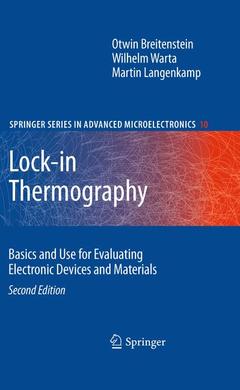Lock-in Thermography (2nd Ed., 2nd ed. 2010) Basics and Use for Evaluating Electronic Devices and Materials Springer Series in Advanced Microelectronics Series, Vol. 10
Langue : Anglais
Auteurs : Breitenstein Otwin, Warta Wilhelm, Langenkamp Martin

In the last 7 years, the ?rst edition of ?Lock-in Thermography? has established as a reference book for all users of this technique for investigating electronic devices, especially solar cells. At this time, a vital further development of lock-in therm- raphy could be observed. Not only the experimental technique was improved by applying new and better infrared cameras, solid immersion lenses, and novel t- ing strategies, but also completely new application ?elds of lock-in thermography were established by implying irradiation of light during the measurements. The two groups of new techniques are different kinds of Illuminated Lock-In Thermography (ILIT) and Carrier Density Imaging, resp. Infrared Lifetime Imaging (CDI/ILM). While ILIT is performed on solar cells, CDI/ILM is performed on bare wafers for imaging the local minority carrier lifetime and the local concentration of trapping centers. The new edition of this book implements these new developments. One new section entitled ?Timing strategies? is added. In this, new ways are introduced to overcome previous limitations of the choice of the lock-in frequency in comparison with the frame rate of the camera. The previous diffraction limit of the spatial resolution can be overcome by a factor of up to 4 by applying so-called solid immersion lenses. This technique is introduced and its application for failure analysis of ICs, where highest possible spatial resolution is desired, is shown in another new section.
Introduction.- Physical and Technical Basics.- Timing Strategies.- Heat Dissipation Mechanisms in Solar Cells.- Carrier Density Imaging.- Illuminated Lock-in Thermography (ILIT).- Experimental Technique.- Theory.- Measurement Strategies.- Typical Applications.- Summary and Outlook
Otwin Breitenstein studied physics at Leipzig university and graduated there in 1980. After dealing with spatially resolved capacitance spectroscopy of point defects (Scanning-DLTS) at the Institute of Solid State Physics and Electron Microscopy in Halle until 1992, he is a scientific staff member at Max Planck Institute of Microstructure Physics, Halle. His main interest field is electronic device and materials analysis by electron microscopic and IR-based methods. Wilhelm Warta studied Physics at Würzburg and then Stuttgart University, where he graduated and received his PhD with research on charge transport properties of organic molecular crystals. 1985 he joined Fraunhofer Institute for Solar Energy Systems in Freiburg starting with work on carrier lifetime measurement techniques for semiconductor materials. His fields are the development of measurement techniques for solar cell development, characterization of solar cell material and solar cells, device and process simulation as well as high precision calibration of solar cells.
Only book in the market on this highly sensitive infrared measurement method Explains the basics and applications of this analytical technique A reference work for researchers and engineers alike Includes supplementary material: sn.pub/extras
Date de parution : 09-2010
Ouvrage de 258 p.
15.5x23.5 cm
© 2024 LAVOISIER S.A.S.
